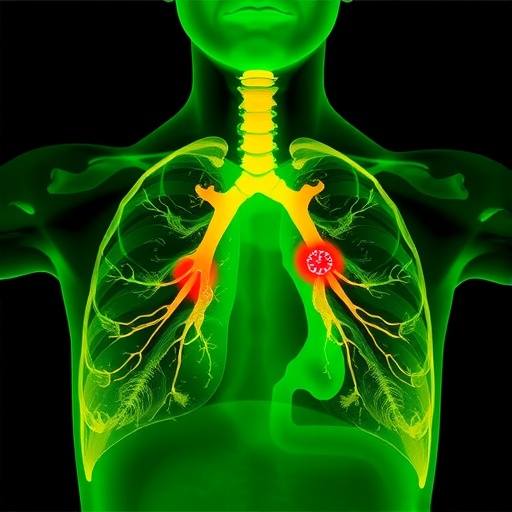The groundbreaking potential of telomere length as a biomarker for early lung cancer detection has emerged as a critical advancement in oncology research. A recent study published in *Heliyon* explores the use of telomere-associated variables (TAV) derived from peripheral blood lymphocytes as predictive markers in high-risk patients undergoing screening for lung cancer. This research heralds a paradigm shift in diagnostic precision, offering hope for improved survival rates through earlier and more accurate detection.
Lung cancer remains the leading cause of cancer-related mortality worldwide, with alarming statistics underscoring the need for effective screening measures. In Spain alone, 21,918 individuals succumbed to lung cancer in 2020, and 30,948 new cases were diagnosed in 2022. While low-dose computed tomography (LDCT) has proven effective in reducing mortality among high-risk patients, the uptake of this screening method remains low, leaving a significant gap in early detection efforts. The study of telomere length offers a novel approach to bridge this gap, presenting a non-invasive, cost-effective, and highly quantifiable biomarker for identifying individuals at heightened risk of lung cancer.
Telomeres, the protective caps at the ends of chromosomes, play a pivotal role in cellular aging and genomic stability. Their shortening is associated with cellular senescence and disease progression, including cancer. However, previous studies investigating the relationship between telomere length and lung cancer have yielded inconsistent results, largely due to variations in study design and measurement techniques. This study overcomes these limitations by employing Telomere Analysis Technology (TAT®), a validated, high-throughput quantitative fluorescence in situ hybridization (HT Q-FISH) platform that provides precise and sensitive telomere length measurements. By analyzing a range of telomere-associated variables, TAT generates unique profiles, or ‘TAV signatures,’ enabling the identification of diagnostic patterns and predictive models.
The study included 233 high-risk patients undergoing lung cancer diagnosis at two Spanish hospitals, alongside a control group comprising 1,378 healthy individuals or patients with chronic obstructive pulmonary disease (COPD). Patients were divided into cohorts based on their diagnosis: lung cancer, COPD, lung cancer with COPD, or no lung disease. Blood samples were collected, and telomere length analysis was performed to assess differences across these groups. The findings revealed that patients in the cancer cohort exhibited significantly shorter telomeres compared to controls, characterized by an overrepresentation of short telomeres and an underrepresentation of long telomeres. These differences were particularly pronounced in patients aged 55-75 years, the demographic most commonly screened for lung cancer.
To translate these observations into clinical practice, the researchers developed predictive models based on TAV analysis. These models were evaluated using Receiver Operating Characteristic (ROC) curves, demonstrating remarkable diagnostic performance. One model, reflecting a lung cancer prevalence of 48% (representative of symptomatic patients), achieved an area under the curve (AUC) of 0.79, with a positive predictive value (PPV) of 0.79 and a negative predictive value (NPV) of 0.83. Another model, designed for asymptomatic high-risk populations with a lung cancer prevalence of 5%, delivered even more impressive results, with an AUC of 0.98, a PPV of 0.60, and an NPV of 0.99. These findings underscore the potential of telomere length analysis to complement existing screening methods, enhancing early detection capabilities and improving outcomes for patients.
This research also highlights the role of smoking and COPD as confounding factors in telomere length variation. Smoking is strongly associated with lung cancer risk and telomere shortening, while COPD accelerates cellular aging and contributes to shorter telomeres. The study cohort’s composition—with 89% of cancer patients being moderate or heavy smokers—suggests a potential enrichment of small cell lung cancer cases, a subtype linked to shorter telomeres. This underscores the need for larger, histology-specific studies to further elucidate the relationship between telomere length and lung cancer subtypes.
While the results are promising, the study acknowledges several limitations. The relatively small sample size and potential histologic biases warrant caution in interpreting the findings. Additionally, telomere length is influenced by genetic, environmental, and lifestyle factors, necessitating further investigation to refine its clinical application. Future studies should aim to validate these findings in larger, more diverse populations and explore the integration of TAV-based models into routine screening protocols.
The implications of this research extend beyond lung cancer screening. The development of non-invasive biomarkers for cancer detection represents a significant advancement in personalized medicine. By leveraging high-throughput technologies and machine learning algorithms, researchers can create sophisticated diagnostic tools that address the complexities of disease risk assessment. The integration of telomere analysis with LDCT and other biomarkers could revolutionize cancer screening, reducing costs and improving accessibility for high-risk populations.
This study represents a collaborative effort by leading researchers and institutions, supported by funding from Horizon2020, Life Length SL, and various regional and national grants. The multidisciplinary approach, combining expertise in oncology, molecular biology, and computational modeling, underscores the potential of collaborative research to drive innovation in cancer diagnostics. As telomere analysis technology continues to evolve, its application in lung cancer screening holds the promise of transforming patient care and saving lives through earlier detection and intervention.
Subject of Research: Telomere-based risk models for early lung cancer diagnosis
Article Title : Telomere-based risk models for the early diagnosis of lung cancer
News Publication Date : December 30, 2024
Article Doi References : https://doi.org/10.1016/j.heliyon.2024.e41040
Image Credits : Scienmag
Keywords : Telomere length, Lung cancer, Cancer risk, Cancer screening, Biomarker





